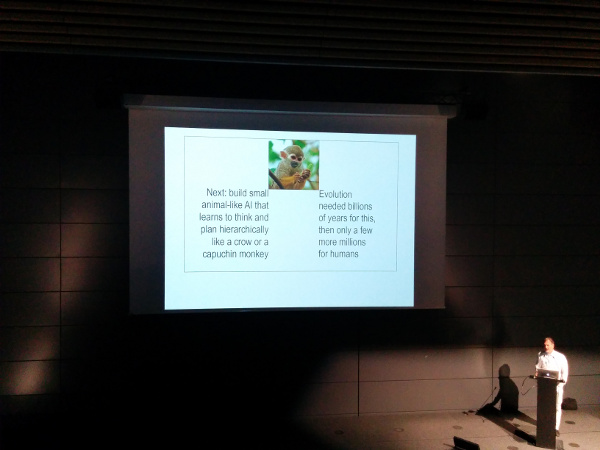Applied Machine Learning Days is a new event set up by Marcel Salathé and his team of the EPFL Lab for Digital Epidemiology. The first edition of appliedmldays.org took place end of January with 450 attendees attending sessions spread across 2 packed days. A second, larger event, is already planned for next year.
The talks covered a variety of use cases across industry and academia using machine learning techniques from traditional classification and regression of one or two variables through probablistic graphical models involving tens and hundreds of variables to deep neural networks which are very popular at the moment. CrowdAI winners had also the opportunity to present their solutions and shared some of their experience. CrowdAI is promissing open platform alternative to Kaggle for machine learning competitions.
I am coincidentally completing Coursera’s specialization in probabilistic graphical models and was excited to be able to relate to some talks with my newly acquired knowledge. Bayesian and Markov networks are fascinating and combine the power of efficient data structures to encode beliefs from a given domain with the power of conditional probabilities - i.e. the chain rule to calculate joint probability distributions and Bayes’ theorem tying the probability of an event occurring to prior knowledge about this event. Check out Kevin Murphy’s intro if you’re curious.
The machine learning community is working hard to make the techniques accessible to a wider audience which might not hold a PhD in physics or mathematics. In addition to MOOCs, a wide number of tools are being made available including TensorFlow or mxnet which were explicitely addressed during talks by Google and Amazon. Facebook Research talked about its FastText library for text representation and classification.
The event was an opportunity to meet Ciro Cattuto of Fondazione ISI in person. Ciro talks about the Data for Good initiative which puts big data at the service of non-profits. ISI can help NGOs tap the requisite and transdisciplinary talent pool required for machine learning projects. Just consider the variety of skills and the speed at which these technologies evolve which make execution challenging, even for well-funded organizations…
Another impressive speaker was Jürgen Schmidhuber with his witty dry humor and extensive experience in deep learning. He walked us through some of the achievements listed in his 2014 paper Deep Learning Neural Networks: An Overview which has over 800 citations at the time of writing.

After his slide on achieving a small animal-like AI, he went on to share his views on estimating the point in the future where we reach Stanislaw Ulam’s Singularity. Schmidhuber set a major event in evolution since the Big Bang every fourth of the elapsed time. Starting with life on Earth at 13.8 x 0.25 = 3.45 billion years, he worked his way through the industrial revolution (at one fourth elapsed since the invetion of gun powder and rockets in China) at 800 down to singularity minus 12 years counting from Internet and WWW with cheap computers with one brain power… This countdown was his way to stress the ambitious research goals and rapid pace of evolution as shown on the slide above.
I couldn’t help thinking of Adam Curtis’ documentary “All Watched Over By Machines Of Loving Grace” though. The recent events in the US and UK are perhaps signs we have already left people behind and the speed of misguided innovation can only further exacerbate cliveages in society. Education is under major pressure for sure. The room was luckily filled in majority with optimists on how technology is there to help society. That included the impressive Nuria Oliver, Chief Data Scientist at DataPop Alliance.
Nuria studied with the MIT folks behind Social Physics and has been working nearly a decade with Telefonica before joining Vodafone as Director of Data Science Research. As we become increasingly dependent on our feature phones or smart phones, mobile operators see an incredible amount of data on people which goes way behond point-to-point voice calls. Operators can harness network signals to display post-quake activites across cities, advise cities on urban planning relative to commuter traffic and mobility or predict crime by location. Nuria presented some of her work at Telefonica on boredom and ways mobile phones could help identify those moments in our day. Use cases include recommending content, shielding us from pesky notifications, recommend activities and… turning off the phone itself! The study was initially based on experience sampling in-situ and collected 40 million events from 54 people over 2 weeks. Supervised learning techniques including SVM and Random Forest were used against against the data with cross validation to yield 75 to 83 percent detection of boredom. A second version of the app was then introduced to a smaller group of 16 people who no longer had to explicitely specify their activity. Instead, the second app used the model identified in the first version and would infer boredom. See Pielot et al. for more details on this project in the tradition of those from the older UCLA CENS programme.
When I think back at projects like Cybersyn which relied on a pre-Internet network, a mainframe to process data and already Bayesian approaches to forecasting, I can only acknowledge the tremendous pace of innovation. But with the tremendous amplification of variety we can handle, we may also have missed opportunties in variety attenuation and identification of balancing feedback loops at various levels of society. That’s why I was excited to see people such as Marcel, Ciro, Nuria, take an active role in driving initiatives to make machine learning accessible to all while remaining mindful of the tyranny of data and the responsibility that comes with technology on its way become indistinguishable from magic.
Thank you to the sponsors as well as Marcel & team for a great event!
 This material is licensed under CC BY 4.0
This material is licensed under CC BY 4.0
